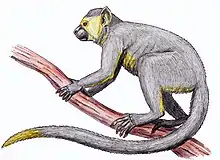Rudapithecus
Rudapithecus is a chimpanzee-like[2] genus of ape which inhabited Europe during the Late Miocene, approximately 10 million years ago. One species is known, Rudapithecus hungaricus.[3][4] The genus name "Rudapithecus" comes from where it was discovered, in Rudabánya, Northern Hungary in 1965 and sent to Budapest in 1967.[2] The specific name "hungaricus" refers to the country where it was discovered, in Hungary.
| Rudapithecus Temporal range: | |
|---|---|
| Scientific classification | |
| Domain: | Eukaryota |
| Kingdom: | Animalia |
| Phylum: | Chordata |
| Class: | Mammalia |
| Order: | Primates |
| Suborder: | Haplorhini |
| Infraorder: | Simiiformes |
| Family: | Hominidae |
| Subfamily: | Homininae |
| Tribe: | †Dryopithecini |
| Genus: | †Rudapithecus Kretzoi, 1969 |
| Species: | †R. hungaricus |
| Binomial name | |
| †Rudapithecus hungaricus Kretzoi, 1969[1] | |
Rudapithecus probably moved among branches like modern apes do now, holding its body upright, and climbing trees with its arms. Rudapithecus hungaricus differed from modern great apes by having a more flexible lumbar, which indicates when Rudapithecus came down to the ground, it might have had the ability to stand upright like humans do. Modern Gorilla, Pan, and Pongo have a long pelvis, and a short lumbar because they are very large animals, which is why they usually walk on all fours. Humans have a longer, more flexible lumbar, which allow humans to stand upright, and walk efficiently on two legs. It is known that Rudapithecus had a more flexible torso than today's apes, because it was much smaller, about the size of a medium-sized dog.[5]
References[6]
- Laszlo Kordos (1987). "Description and reconstruction of the skull of Rudapithecus hungaricus Kretzoi (Mammalia)". Annales Musei historico-naturalis hungarici. Hungarian Natural History Museum. 79. ISSN 0521-4726. Retrieved 5 August 2017.
- László Kordos: 50 years of Rudapithecus (in Hungarian)
- University of Missouri (17 September 2019). "Rare 10 million-year-old fossil unearths new view of human evolution". Phys.org. Retrieved 17 September 2019.
- Begun, David (2009). "Dryopithecins, Darwin, de Bonis, and the European origin of the African apes and human clade". Geodiversitas. 3 (1): 789–816. doi:10.5252/g2009n4a789. S2CID 131688092.
- "Rare 10 million-year-old fossil unearths new view of human evolution // Show Me Mizzou // University of Missouri". showme.missouri.edu. Retrieved 2020-11-02.
- "Rudapithecus of Rudabánya, Hungary". Hungarian Spectrum. 2009-08-16. Retrieved 2020-10-22.



